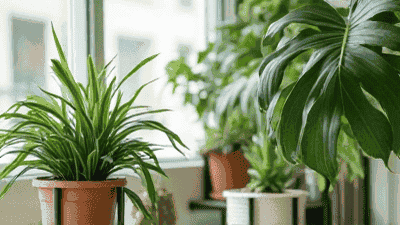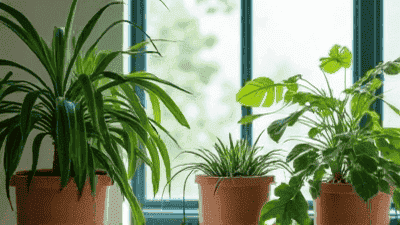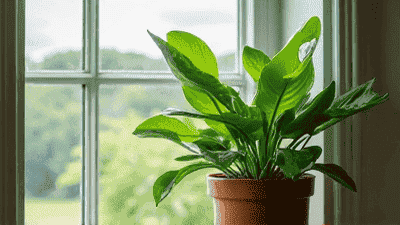
Indoor plants have taken the world of interior design by storm, and for good reason. They add not only beauty and charm to a space but also contribute to our well-being by improving air quality, reducing stress, and enhancing overall ambiance.
Before diving into the aesthetic aspects, it is essential to understand the myriad benefits that indoor plants offer, making them a perfect addition to any home.
One of the most significant advantages of indoor plants is their ability to improve air quality. They remove toxins, such as formaldehyde, benzene, and carbon monoxide, from the air through the process of photosynthesis. Research conducted by NASA suggests that certain plants can effectively purify indoor air, making it safer and healthier for inhabitants.
Indoor plants release moisture vapor into the air through a process called transpiration. This increase in humidity can be particularly beneficial in dry climates or during winter when indoor heating can cause the air to become dry. Higher humidity can lead to healthier skin, reduced respiratory problems, and improved comfort levels.
Having indoor plants has been shown to reduce stress and anxiety. The presence of greenery can evoke a sense of calm, making it easier to relax and unwind. Studies have also indicated that incorporating plants into your workspace can enhance concentration and productivity, ultimately contributing to a more positive mood.
Indoor plants can dramatically enhance the aesthetic appeal of a space. Their vibrant colors, varied shapes, and textures introduce life and character into otherwise bland environments. The addition of plants can create focal points, improve visual interest, and even complement existing decor styles.
In our increasingly urbanized world, indoor plants provide a vital connection to nature. Surrounding ourselves with greenery reminds us of the outdoors and creates a sense of tranquility in our homes. This connection can improve our overall sense of well-being and promote a healthier lifestyle.

With so many indoor plants available, selecting the right ones for your space can be overwhelming. Here are several factors to consider when choosing indoor plants for your home.
Different plants have varying light requirements. Some thrive in bright, direct sunlight, while others prefer low-light conditions. It's essential to assess the lighting in your home before making a selection.
Evaluate the size of your available space and choose plants that fit well within it. Taller plants like fiddle leaf figs can make a statement, while smaller plants like succulents are perfect for tabletops or shelves. Grouping plants of varying sizes can create an appealing visual hierarchy.
Consider your commitment to plant care when selecting indoor plants. Some plants require more attention than others.
Ultimately, your personal preference should guide your plant selection. Choose plants that resonate with you and complement your home's aesthetic. From lush foliage to unique shapes, the right plants can enhance your overall design scheme.
Now that you understand the benefits and have chosen your indoor plants, it’s time to explore how to incorporate them into your home decor effectively.
Use larger plants to create focal points in a room. Position them in corners, next to furniture pieces, or near windows to draw the eye and add dimension to your space. A tall snake plant or a fiddle leaf fig makes a bold statement and adds height.
Combining multiple plants creates a vibrant and lush display. Choose plants with varying heights, textures, and colors to create visual interest. Use plant stands, shelves, or decorative trays to elevate the group and give it structure.
The choice of containers can elevate the design of your indoor plants. Experiment with unique pots and planters that complement your decor style. Terracotta pots evoke a rustic charm, while ceramic or metallic containers can add a modern touch.
Consider the various areas of your home when deciding where to place plants. Here are some ideas:
A "shelfie" is an organized combination of plants and decorative items displayed on shelves. Use a mix of plant sizes, books, and decorative objects to create an attractive and lively arrangement. Layer different heights and place items in groups for added interest.

Taking care of indoor plants is key to their survival and vitality. Although many plants are relatively low-maintenance, understanding specific care requirements is crucial.
Overwatering is one of the most common mistakes made by plant owners. Different plants have different watering needs:
To avoid overwatering, always check the moisture level of the soil with your finger before watering.
Continue to monitor your plants' light needs and adjust their placement as necessary. Rotate pots once a month to ensure even growth on all sides and to prevent them from leaning toward the light.
Many indoor plants thrive in higher humidity levels. To increase humidity, consider the following options:
Regular fertilization can help plants grow and flourish. Use a balanced indoor plant fertilizer during the growing season (spring and summer). Follow the instructions on the packaging to avoid nutrient burn.
Regular pruning encourages healthy growth and maintains the desired shape of your plants. Remove dead or yellowing leaves, and trim leggy growth to promote bushier plants.
Establishing a plant care routine will help ensure the health and vitality of your indoor plants. Here are some steps to consider when creating your routine:

Selecting the right indoor plants for each room can maximize the benefits they provide while enhancing your home decor. Below is a guide to recommend plants suited for various areas of the home.
The charm of indoor plants lies in their ability to bring vitality, freshness, and life into your home. As we explore the various benefits, care requirements, and aesthetic enhancements that plants can provide, it becomes clear why so many individuals are drawn to incorporating greenery into their living spaces.
By selecting the right plants for your environment, establishing a routine for care, and thoughtfully designing your space, you can create a vibrant indoor ecosystem that complements your lifestyle and enhances your overall well-being.
Incorporating indoor plants into your home is not merely an aesthetic choice; it is a lifestyle decision that promotes health, happiness, and connection to nature. With proper care and placement, your indoor plants will flourish, transforming your home into an inviting sanctuary that invigorates both body and mind.